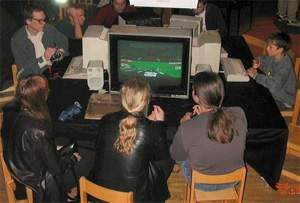
Report: Electronic kindergarten

On May 18-26, 2001 - a couple of months before SIGGRAPH 2001 - a public demo presentation took place in Vienna, Austria. "electronic kindergarten" was the name of the event at which this happened. In fact demos were just a part of the show: the main theme was the home computer culture of the 1980s.
"The event electronic kindergarten showed the enormous impact of that time on the development of sub-cultures and technologies that have influenced and considerably shaped our media culture up until today," says Mirko Tobias Schäfer, one of the organisers. "In this context it pointed to the cracker scene of the eighties and presented demos from this period of time. The pirate scene of the eighties is an example of a new sub-culture with its own code (respect) and its own area of representation (demos) as well as its own channels of distribution, independent of traditional, capitalistic ones."
Electronic kindergarten was organised by the association [d]vision, which describes itself as a "platform for digital culture" and a "bridge from the analog to the digital world, as well as from Vienna to Europe". "[d]vision organises the International Festival For Digital Culture in Vienna. The way [d]vision works resembles a surfing through the dense complex of themes of the current media culture. [d]vision fetches topics which we regard as important and on which we would like to lay more emphasis in the international discourse. [d]vision does not lag behind the discourse but actively participates in shaping it", Mirko explains.

Electronic kindergarten was physically split into two parts: During the entire week, three rooms in the WUK (Werkstätten- und Kulturhaus), a popular meeting place of alternative artists, were open for visitors interested in the exhibition of home computers, classic games and demos. As a fitting decoration, the walls of the WUK rooms were covered by "Ministeck" mosaics created by the artist Norbert Bayer, showing motifs of classic games like Space Invaders and Great Giana Sisters. In the evenings, movies considered typical of the eighties, such as Star Wars and Tron, were shown at the Schikaneder cinema.

In one of the WUK rooms, a tape with 14 modern demos and intros from the past two years was constantly being played on a 16x9 screen. In addition, on several occasions (one of them being the opening) the demos were shown by means of a projector. Some titles: Haugyjob by Astral, Heaven Seven by Exceed, .the .product by farbrausch, holiday with president by MFX, A simple way by Vantage, and Caillou by Mandarine. These demos were also included on a CD visitors could win at little games-contests.
The members of [d]vision consider it important to point to the achievements of the demoscene as they regard them as highly influential on media culture. To quote Mirko again: "We suppose that the demomakers' activity is not an endless loop within a hermetically isolated community but that members of this scene considerably influence media culture when they design media outside the demoscene."
Most of the visitors - artists, school-children and the general public - had never heard of the demoscene before. Judging from my observations at the opening, only demos with some kind of artistic message really impressed the audience. Especially women were rather interested in the bar than in watching the demos. This may be due to a lack of explanation: After a quick introduction to the demoscene, the demos were presented one after another, non-stop, without any further comments. It might have been a better idea to interrupt the presentation after each demo and explain what's special about the next one. Perhaps one should have also handed out a folder with such information before the beginning of the presentation.

On the other hand, it is questionable whether people who are little familiar with the mathematical and technical aspects of demos can be fascinated by arguments such as "this is calculated in real-time" or "all code and data occupy just 64kb". The general public is not interested in the process of generation, but the outward appearance. From this point of view it's doubtful that purely technical demos will ever have a chance to become popular among non-experts.
On Sunday, May 20, families with small children constituted a large part of the visitors. The children were most fascinated by the opportunity to play oldskool games such as Bubble Bobble and Lotus 1-2-3 on computers like C64, Amiga 1200, Atari ST, and game consoles such as Colecovision and NES. It may also be worth mentioning that the exhibition featured an original Donkey Kong gaming-machine.

What attracted people of all ages was the glTron contest - a nice combination of a little opportunity to play and a demonstration of how the movies of the eighties continue to inspire today's programmers. Four people played simultaneously, sharing one keyboard, which created a kind of "intimate" atmosphere, as one of the players remarked.
The organisers would like to thank the demoscene for the "pleasant" and "uncomplicated" cooperation; they are happy that many sceners submitted information and material, which allowed [d]vision to present a "fabulous" selection of demos. They plan to keep in contact with the scene and continue presenting demos in the future.